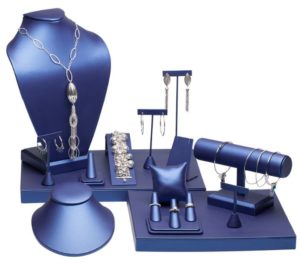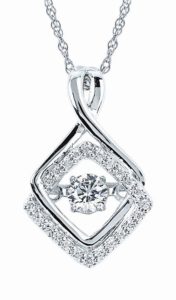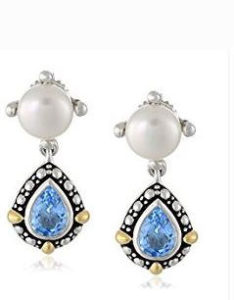How You Sell It
“Success today is less about what you sell, and more about how you sell it,” promotes Pam Danziger, president of Unity Marketing, Stevens, Pennsylvania. The author of “Shops That Pop” advocates jewelers keep the focus on value not price, curating products and offering services unique to their customers.
 Create an environment that’s immersive and inspiring, both in store and online that encourages participants to tell a great story about the brand, advocates Pam Levine, Levine Luxury Branding, New York says “Seamlessly weave and fully integrate digital activation and social media with every facet of the marketing mix to leverage user generated content and participation. It’s more about connections and memorable experiences than a brand ‘look at me’ moment.”
Create an environment that’s immersive and inspiring, both in store and online that encourages participants to tell a great story about the brand, advocates Pam Levine, Levine Luxury Branding, New York says “Seamlessly weave and fully integrate digital activation and social media with every facet of the marketing mix to leverage user generated content and participation. It’s more about connections and memorable experiences than a brand ‘look at me’ moment.”
Subject Matters
Levine describes the concept as collecting conversations, working themes that allow us to escape, give us ideas, and guide us to make choices. She suggests using colors and language to tell stories year round. Imagine white for holiday, winter and wedding—snow and winter photos as the backdrop to pop gemstone jewelry. Or play with words that inspire like “joy” and “reflection”, evoking happy times and people we love with reflective surfaces, family photos, poetry.
She advises jewelers look beyond the jewelry industry for inspiration on displays and presentation, and create their own Pinterest page of ideas, offering up these websites to muse: mindfuldesignconsulting.com, windowswear.com, christinetaylorcollection.com, zengenius.com, acedesigns.com, and visualciti.com.
Gift giving occasions happen every day, so jewelers should keep gift ideas front of mind by setting scenes that plant seeds and offer guidance. “It doesn’t have to be overwhelming,” says Denise Cabrera, product manager, display and packaging, Rio Grande, a Richline brand in Albuquerque, New Mexico. “Use props, interesting fabrics and paper, photography, and signage that call attention to gifting opportunities. Consumers faced with myriad options want the direction.”
 Scott Rauch, president SHR Jewelry Group, a division of SDC Designs, New York, sees this concept in action with its Miracle Links, a patent-pending circle necklace promoted to celebrate the birth of a child. He says research his company conducted shows most moms open to receiving jewelry as a “push present” and dads eager to give it, but don’t know what to get. Calling attention to how to mark this life-changing moment in a meaningful way has been successful for the brand.
Scott Rauch, president SHR Jewelry Group, a division of SDC Designs, New York, sees this concept in action with its Miracle Links, a patent-pending circle necklace promoted to celebrate the birth of a child. He says research his company conducted shows most moms open to receiving jewelry as a “push present” and dads eager to give it, but don’t know what to get. Calling attention to how to mark this life-changing moment in a meaningful way has been successful for the brand.
Rauch also sees retailers focus on men’s jewelry presentations doing well with the category. He cites success with the company’s new Esquire brand because it identifies bestselling men’s styles curated with the authority on men’s style. IB Goodman is effectively highlighting men’s gifts too, with its “wingman” campaign that reminds consumers to celebrate the men they can count on. Ruth Grothaus, merchandise manager for the Newport, Kentucky brand says men are hard to buy for, so highlighting gifts in store and online help consumers narrow the field.
Jewelers can engage, inspire and guide customers to buy based on their merchandising presentations, says Maren Pfister, merchandise manager, Ostbye, Minneapolis, Minnesota. She says her company has been very successful with its Top 10 Gifts Program that displays bestselling gifts in a range of prices. Jewelers can emulate that by setting scenes for different occasions and changing out pieces regularly to keep things fresh.
 Levine also encourages jewelers host meaningful in store events, invite specialists like stylists and wedding planners to meet with best customers, cross promote with non-competing businesses their clients frequent, and partner with charities significant to their audience.
Levine also encourages jewelers host meaningful in store events, invite specialists like stylists and wedding planners to meet with best customers, cross promote with non-competing businesses their clients frequent, and partner with charities significant to their audience.
Cabrera notes that something as simple as complimentary gift-wrap can elevate the buying experience. “It doesn’t take a lot of time or a big investment, but adds so much to the interaction.” She says while jewelers may have boxes, bags and wrap in their store color, a change in packaging details like different ribbon or tissue paper colors that speak to specific occasions make it even more special.
Happiness Equation
As important as the in-store experience, Levine hails the before and after integral parts of the equation, citing Lippincott’s “Happiness Halo”. Happiness is as much about how we look forward to and look back on an event, as it is the event itself.
Lippincott research found companies are thinking too narrowly about the customer interaction, missing moments when engagement might be more compelling. It found that half of someone’s happiness is built in moments of anticipation and remembering. Think party or vacation. Levine notes that a jeweler’s virtual reality can be very useful in nurturing the front and back ends of the experience encouraging story and picture sharing, contests, and more.
To tap into the happiness equation, determine: What can your brand hide to build excitement during anticipation? What can your brand expose to give customers something to look forward to? What moments of your brand experience might be a limited-time treat for customers? How can your brand encourage customers to immerse themselves in your experience? How can you focus choice in a way that feels helpful not limiting? How can you make customers feel superior? What’s your last impression and how can you make it a happy memory? What surprises can your brand deliver to bring unexpected joy to the afterglow? What can your brand do to reinforce your positives and rewrite your negatives?







